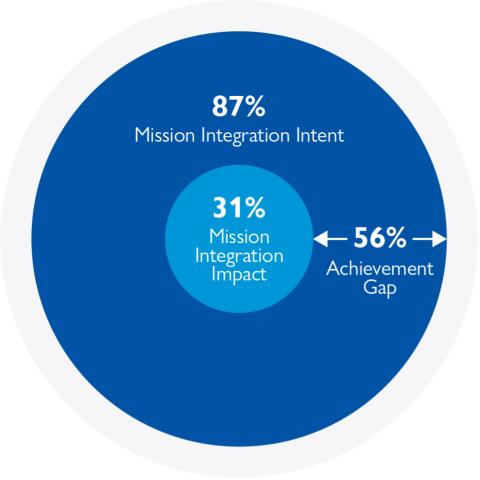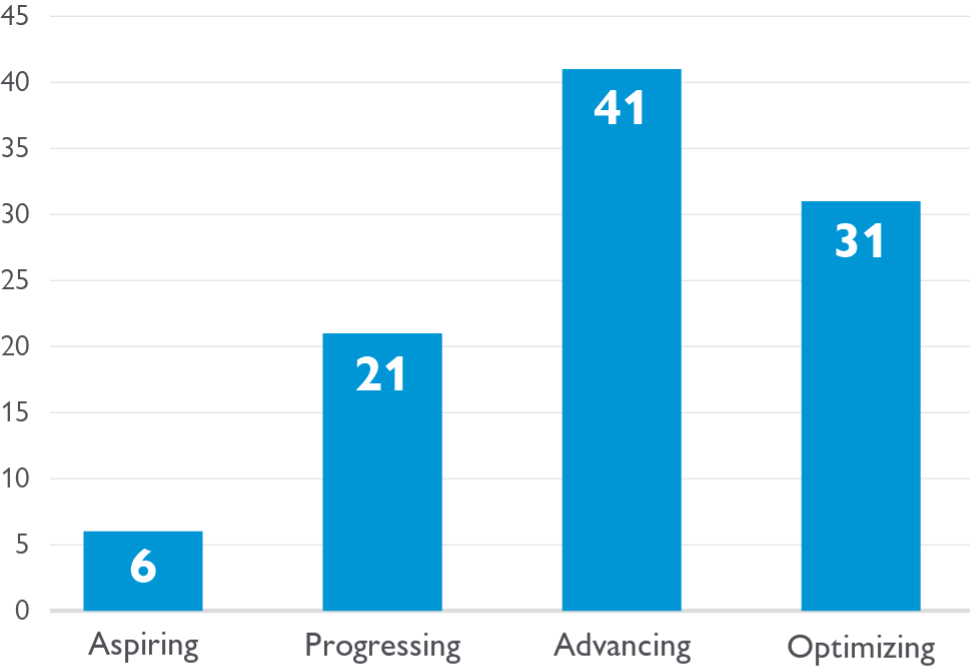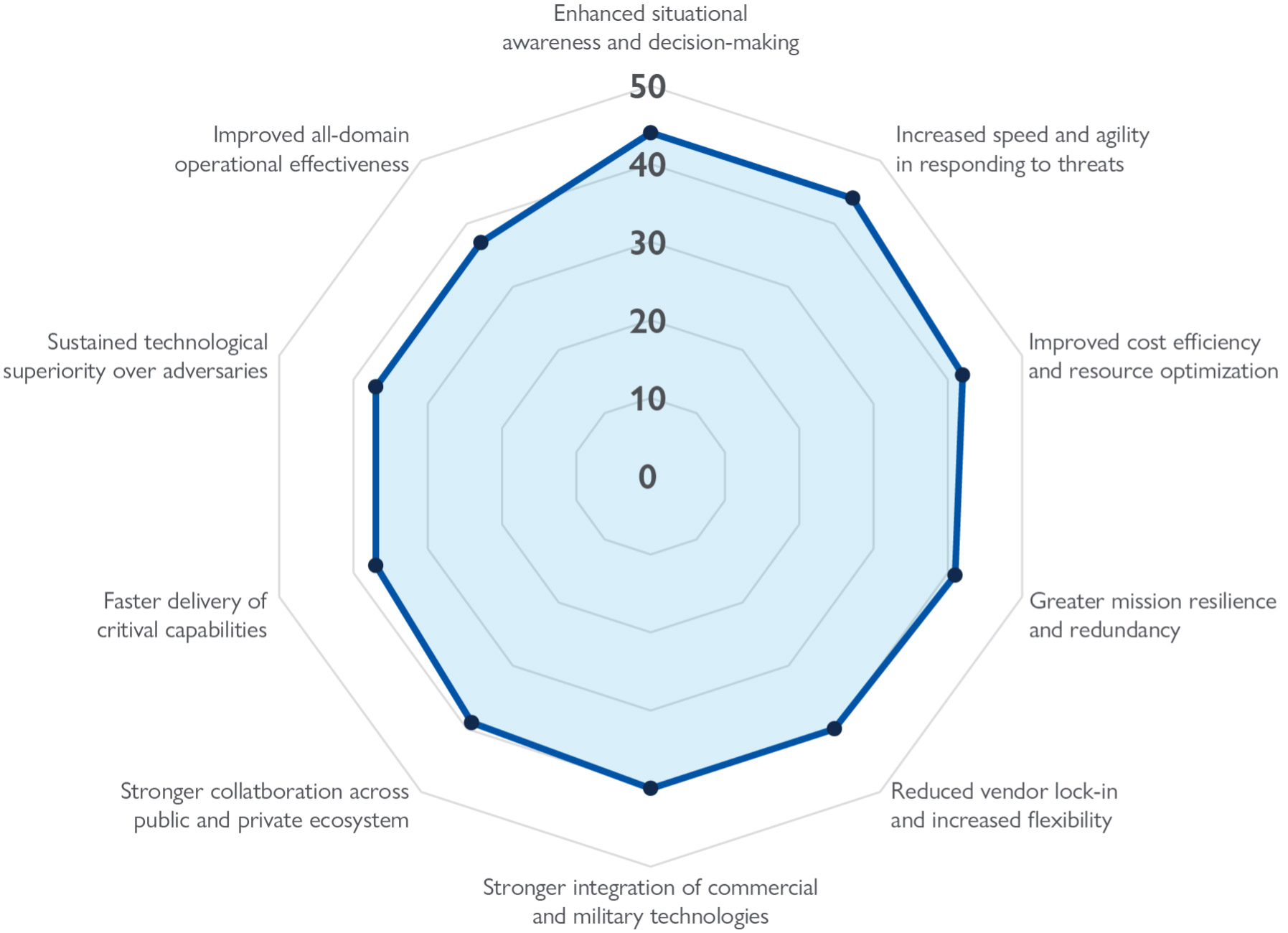Eighty-seven percent of U.S. federal leaders say that mission integration is a massive or significant contribution to service or agency success. Yet only 31% have achieved it. While leaders acknowledge implementation challenges, they know the key capabilities for operationalizing mission integration.
WHAT IS MISSION INTEGRATION?
Mission integration fuses emerging technologies and best-in-class commercial solutions with existing systems to deliver transformative mission outcomes. By leveraging deep mission experience, advanced technology expertise and a collaborative ecosystem of stakeholders, mission integration ensures the security, agility and interoperability of critical capabilities to advance national priorities.
Federal government leaders are under pressure to deliver value, speed and efficiency with government technology. Most importantly, they must deliver mission critical outcomes like assuring American military dominance and securing its borders. Yet data silos slow data-driven decision-making in federal agencies from the enterprise to the edge. And the best commercial innovation is not designed to meet mission demands. Mission integration that brings together commercial, legacy and emerging technologies is essential to move past these challenges.
Federal IT Modernization: A Wide Gap Between Intent and Impact
SAIC surveyed federal defense, intelligence and civilian leaders to get their perspectives on mission integration in relation to federal IT modernization. The consensus is clear. Eighty-seven percent view it as a massive or significant contribution to service or agency success. Yet only 31% have achieved it. This is a 56% achievement gap between strategic intent and operational impact (Figure 1).

Figure 1: The achievement gap between intent and impact in mission integration
Q: Based on the definition of mission integration, to what extent would effective mission integration contribute to the success of your broader service or agency and its overarching mission? (Please select one: No contribution, Minimal contribution, Some contribution, Significant contribution, Massive contribution)
Source: SAIC 2025 U.S. Federal Leaders Mission Integration Survey
Implementation is Continuous—and Challenging
There is no end state when it comes to implementing mission integration as a means of modernizing federal IT. With threats, technologies and capabilities changing constantly, implementation must be continuous. Federal organizations are at different phases of mission integration maturity (Figure 2). Most (72%) are in the advancing or optimizing phases, with 31% reaching optimization.

Aspiring: We have a defined plan to achieve mission integration.
Progressing: We have achieved aspects of mission integration.
Advancing: We expect to achieve all aspects of mission integration within the next year.
Optimizing: We have achieved mission integration.
Figure 2: The four phases of mission integration maturity
Q: Based on the above definition of mission integration, how close is your organization to achieving mission integration today? (Please select one: Not at all close, Not close, Somewhat close, Close, Very Close, We have achieved mission integration, Not-Applicable)
Source: SAIC 2025 U.S. Federal Leaders Mission Integration Survey
Despite progress like this, 68% of federal organizations have yet to reach the optimizing phase. This points to significant challenges to operationalizing mission integration (see below), which are being intensified by complexity. National security settings, the U.S. southern border and the space frontier are all endlessly complex. There is no room for error when it comes to mission imperatives.

Table 1. Top five challenges to mission success
Q: What are the three most significant external challenges to the success of your mission? (Please rank the top three challenges from 1 to 3, with 1 being the most important)
Source: SAIC 2025 U.S. Federal Leaders Mission Integration Survey
Benefits of Mission System Integration
In this environment, leaders rank enhanced situational awareness and decision-making (44%) and increased speed and agility in responding to threats (44%) as the most valuable outcomes of mission integration in driving the success of their organization and mission. Interestingly, the rankings of ten possible outcomes have just a 7% spread. This clustering signals that all of these outcomes are equally valuable to achieve (Figure 3).

Figure 3: Valuable outcomes from mission integration
Q: How valuable would each of the outcomes of Mission Integration in driving the success of your organization and its mission? (Please rate each of the following outcomes on a scale of 1 to 5, where 1 = Not at all Valuable and 5 = Very Valuable.”)
Source: SAIC 2025 U.S. Federal Leaders Mission Integration Survey
Why Mission Success Demands More Than Just New Technology
“
Introducing more technology isn’t enough to win America’s wars, secure its borders or dominate in space. America’s decisions, deterrence, and asymmetric advantage hinge on complex data and network integrations—across US services and coalition partners—combined with the precision deployment of tech-enabled munitions and weapons systems. The Department of Defense needs private-sector-led mission integration, ready to be rapidly integrated, secured and scaled, to drive mission success.
”
— Toni Townes-Whitley | CEO, SAIC
for Forbes Business Council
Best Practices for Mission Integration
Achieving outcomes is mission critical. This is why federal leaders recognize the imperative of mission integration. Maintaining the nation’s military strength, securing its borders and protecting its critical infrastructure can’t happen in isolation. It hinges on connecting the industrial innovation ecosystem in new ways and unlocking data insights through mission integration. This is challenging work. Fortunately, federal leaders have ideas on the fundamentals for success.
According to federal leaders, the four most important elements contributing to their successful deployment of mission integration (in ranking order) are:
- Strategic, outside-in perspectives on current and future mission environments. Federal leaders have a deep understanding of the mission. It is their compass. Yet their focus on the mission and day-to-day operations makes it hard to benefit from evolving vantage points. Well-informed, outside-in perspectives from vendors with a deep understanding of both the technology ecosystem and business application can elevate speed and quality. Mission integrators can help bridge legacy and emerging technologies and make commercial innovation mission-ready.
- Enhanced agility and adaptability in procurement and contract execution. Federal organizations need ready access to mission integrators. Only they can quickly, securely and efficiently integrate the best commercial technology with military and civilian systems for meaningful results. But these bridge-builders don’t fit traditional contracting norms. Federal acquisition reform that includes mission integration as a defined procurement scope can remove bottlenecks and help government field solutions faster.
- Commitment to efficiency with immediate execution and ongoing cost reduction. Defense and civilian organizations need speed, scale and optionality—with efficiency. Like mission integration itself, efficiency initiatives must be continuous. The best way to sustain efficiency is with data-informed insights. Leaders require insights based on all available datasets to make the most informed decisions. The more that organizations are set up to drive operational advantage from data, the more efficient they can be, now and in the future.
- A track record with and commitment to using secure, open-source systems. Custom-coded systems are liabilities to readiness and responsiveness. This is why solutions from technology providers should conform to open architecture standards. With open-source systems, defense and civilian organizations can respond quickly to emerging threats. Open-source systems encourage innovation by facilitating experimentation and rapid iteration. Additionally, they can reduce data interoperability issues and enable seamless, secure data exchange within and across agencies.
Multiply Outcomes with Mission Integration
Federal leaders have developed a mission integration mindset—a near universal embrace of mission integration as a driver of success. This understanding is a necessary first step to implementing mission integration broadly across federal defense, intelligence and civilian organizations. The more intentional that leaders are about this implementation, the better the outcomes they deliver. When deployed with consistency, mission integration becomes an outcomes multiplier— and one that is required for today’s complex mission environments.
Learn how SAIC turns mission integration into mission impact

